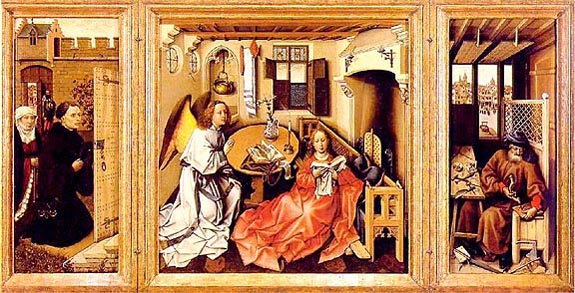Split screen is the combination of two or more scenes films separately which appear in the same frame.
Religious art exploited the idea of multiple images for centuries. One prominent example is the Merode Altarpiece, from the mid-fifteenth century.
Triptych paintings featured a main central image, flanked on both sides by two or more generally related images. The concept of triptychs was one of the many painterly conventions co-opted by cinema from its inception.
Ephraim Katz has written that Raoul Gromoin-Sanson patented what was called a Cineorama multi-screen system in 1897. The first public presentation of the system, at the 1900 World Exposition in Paris, featured ten synchronized projectors simultaneously showing ten images on a circular panoramic screen. The attraction was so sensational that the police were forced to close it after just three performances, in the interest of crowd control and public safety.
Despite the sensation, the system failed to become a standard within the cost-conscious popular film industry. But the French director Abel Gance wanted an epic visual quality for the making of his national paean, Napoleon, in 1927. It was decades before wide-screen lenses would become generally available, so Gance recalled Cinerama and used three projectors and three screens in a system he called Polyvision. At times, Gance used the system to create a triptych effect of three visually disconnected images. At other times, he used the three-screen technique to create one wide and cohesive image.
Napoleon accomplished Gance’s vision, but, once again, the multi-projector concept was shunted aside as impractical. Still, filmmakers continued to experiment with the idea of splitting the screen, often to amusing effect. A related example of split screen is the wipe.
Split screen made one notable appearance in the 1950s. The Production Code had been limiting sexual content for decades, so the director Michael Gordon pushed the envelope in Pillow Talk (1959). His comic use of split screen allowed his film to stay true to the letter of the Code, while also suggesting that the stars of the film, Rock Hudson and Doris Day, were breaking taboos by apparently sharing a bed and a bathtub.
The Op Art movement of the 1960s reinvigorated the use of split screen. The young Brian DePalma was quick to play with the device. In Sisters (1973), he used multiple images to simultaneously involve and disorient the viewer. He advanced this notion during the climactic sequence in Carrie (1976).
As Op Art passed into history, split screen again fell out of favor. But it still has its uses. Gus Van Sant’s To Die For (1995) makes a darkly comic statement about the mass-media culture and the hunger for television fame. The closing image involves a shot of the least likely achiever of such fame. Van Sant’s use of split screen efficiently suggests that becoming a media star is largely a matter of whimsical fate.
Mike Figgis’s Timecode (2000) offered a new approach to the use of split screen, as the film was shot digitally and screened in four concurrent ninety-minute takes.
